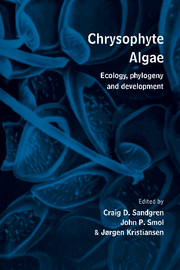Book contents
- Frontmatter
- Contents
- Preface
- List of contributors
- 1 History of chrysophyte research: origin and development of concepts and ideas
- Part I Phylogeny, systematics and evolution
- Part II Development, physiology and nutrition
- Part III Ecology, paleoecology and reproduction
- Part IV Contributed original papers
- 14 Mallomonas variabilis, sp. nov. (Synurophyceae) with stomatocysts found in Lake Konnevesi, Finland
- 15 Scale morphology and growth characteristics of clones of Synura petersenii (Synurophyceae) at different temperatures
- 16 Status of the Chrysamoebales (Chrysophyceae): observations on Chrysamoeba pyrenoidifera, Rhizochromulina marina and Lagynion delicatulum
- 17 The genus Paraphysomonas from Indian rivers, lakes, ponds and tanks
- Index of scientific names
- Subject index
16 - Status of the Chrysamoebales (Chrysophyceae): observations on Chrysamoeba pyrenoidifera, Rhizochromulina marina and Lagynion delicatulum
Published online by Cambridge University Press: 05 March 2012
- Frontmatter
- Contents
- Preface
- List of contributors
- 1 History of chrysophyte research: origin and development of concepts and ideas
- Part I Phylogeny, systematics and evolution
- Part II Development, physiology and nutrition
- Part III Ecology, paleoecology and reproduction
- Part IV Contributed original papers
- 14 Mallomonas variabilis, sp. nov. (Synurophyceae) with stomatocysts found in Lake Konnevesi, Finland
- 15 Scale morphology and growth characteristics of clones of Synura petersenii (Synurophyceae) at different temperatures
- 16 Status of the Chrysamoebales (Chrysophyceae): observations on Chrysamoeba pyrenoidifera, Rhizochromulina marina and Lagynion delicatulum
- 17 The genus Paraphysomonas from Indian rivers, lakes, ponds and tanks
- Index of scientific names
- Subject index
Summary
Introduction
Until fairly recently, most concepts of higher taxa in the Chrysophyceae have been based on some combination of vegetative morphological features and flagellar number, position and behavior. Application of ultrastructural and molecular techniques to chrysophyte systematics research in the last few years has led to major taxonomic changes (Andersen et al. 1993; Moestrup, this volume; Preisig, this volume). However, the small number and limited diversity of species examined critically to date hampers further progress.
One concept that has been particularly difficult to evaluate, for lack of evidence, is that of the order Chrysamoebales, erected to accommodate chrysophytes that have ameboid (‘rhizopodial’) vegetative cells ‘during the greater part of [the] life history’ (Kristiansen 1990: pp. 439, 441). There have been few accounts of general ultrastructure in ameboid chrysophytes (Hibberd 1971, 1976; Hibberd & Chretiennot-Dinet 1979; Grell et al. 1990), and none on the detailed architecture of their flagellar apparatus.
Isolation into unialgal culture of two ameboid chrysophytes from New Zealand freshwaters – Chrysamoeba pyrenoidifera Korshikov and Lagynion delicatulum Skuja – prompted us to investigate their ultrastructure in detail and, in addition, to re-examine the marine species Rhizochromulina marina Hibberd et Chretiennot-Dinet. This paper summarizes the results of these investigations and thereby assesses the validity and status of the Chrysamoebales. Comprehensive accounts of the structure and reproduction of C. pyrenoidifera and L. delicatulum will appear elsewhere.
- Type
- Chapter
- Information
- Chrysophyte AlgaeEcology, Phylogeny and Development, pp. 361 - 372Publisher: Cambridge University PressPrint publication year: 1995
- 5
- Cited by



